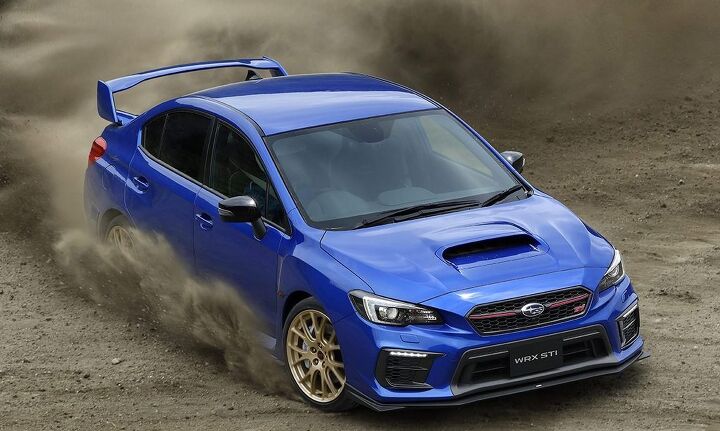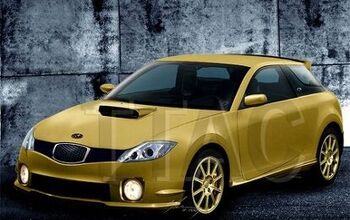Subaru Says No WRX STI, Suggests Electric Model

When Subaru announced the latest WRX sedan, it was made perfectly clear that it would arrive without the high-performance STI variant metaphorically in tow. After attempting to push performance versions of the Impreza sedan into becoming their own thing for years, the 2022 model year saw the WRX jumping onto the Subaru Global Platform. This resulted in a more mainstream vehicle we assumed would need additional time in the relevant skunkworks garage before it could reemerge as the aggressive, rally-inspired, no-nonsense WRX STI.
But Subaru is now saying that there won’t be an STI for this generation. According to the manufacturer, “future sports and performance cars should evolve to meet the needs of the changing marketplace and the regulations and requirements for greenhouse gasses (GHG), zero emissions vehicles (ZEV), and Corporate Average Fuel Economy (CAFE).”
That means environmental regulations have effectively killed the STI as we know it. Though we imagine the automaker probably could have made it work. The current WRX saw its displacement upsized by nearly 20 percent, so it doesn’t seem wholly ridiculous to assume Subaru could have designed a juiced-up version of that car without offending government regulators. But the manufacturer has said it’s better to focus on electrification, citing the automotive industry’s overt push to sell more EVs and alleged environmental stewardship.
From Subaru:
As part of that effort, Subaru Corporation is exploring opportunities for the next generation Subaru WRX STI, including electrification. In the meantime, a next generation internal combustion engine WRX STI will not be produced based upon the new WRX platform.
The Subaru WRX STI and the STI brand represent the zenith of Subaru’s performance vehicles exemplifying Subaru’s unique DNA and rally heritage. As we look to the future, we also look forward to incorporating the essence of STI into our next generation of vehicles.
However, it still feels like there’s some gaslighting afoot. The automaker’s singular electrified model is the plug-in-hybrid variant of the Crosstrek and it has no battery electric vehicles to speak of, at least not until the subcompact Solterra SUV (co-developed with the Toyota bZ4X) arrives later this year. This time last year, Subaru was also stating that the WRX and STI would be the very last models in Subaru’s lineup to undergo electrification.
Heck, there were numerous credible leaks suggesting the STI would get the same FA24 2.4-liter direct-injection turbocharged Boxer engine as the new WRX — just with 395 horsepower and noteworthy bumps in efficiency. While the brand had endured numerous delays in development, those were attributed to working through COVID restrictions with the overarching plans going unchanged.
Now, Subaru is suggesting it’s better to ax the STI sedan to focus on efficiencies as it simultaneously discusses using Subaru Tecnica International to add performance to the rest of its lineup. But this just leaves us with more questions. Will the STI badge denote tangible improvements in physics or simply become an appearance package? Numerous brands have done this already by creating cosmetic focused variants that sit below genuine performance options while still leaning on the relevant badging (e.g. Ford’s ST-Line or Hyundai’s N-Line). Will the proposed STI-Line be exclusive to all-electric models, adhering to Subaru’s earlier statements about the importance of zero-emission vehicles, or will they also encompass internal combustion models?
Maybe this is all just a coy way of suggesting the WRX STI will soldier onward using the current platform until an entirely new model has been designed as a hybrid/BEV or it simply changes its mind. Subaru is being extremely cagey on the matter, so it’s really anybody’s guess at this point. Feel free to speculate in the comments as I continue losing interest in this company.
[Image: Subaru]

Consumer advocate tracking industry trends and regulations. Before joining TTAC, Matt spent a decade working for marketing and research firms based in NYC. Clients included several of the world’s largest automakers, global tire brands, and aftermarket part suppliers. Dissatisfied, he pivoted to writing about cars. Since then, he has become an ardent supporter of the right-to-repair movement, been interviewed about the automotive sector by national broadcasts, participated in a few amateur rallying events, and driven more rental cars than anyone ever should. Handy with a wrench, Matt grew up surrounded by Detroit auto workers and learned to drive by twelve. A contrarian, Matt claims to prefer understeer and motorcycles.
More by Matt Posky
Latest Car Reviews
Read moreLatest Product Reviews
Read moreRecent Comments
- Lorenzo If it's over 30 years old and over 80k miles, and not a classic, it's a parts car, worth no more than 20% of original price.
- Dusterdude No mileage noted on a 33 year old car means likely well north of 300k + miles , along with issues noted , should equate to an ask price of less than $3k
- Ajla IMO, something like this really should be naturally-aspirated.
- Kjhkjlhkjhkljh kljhjkhjklhkjh Unless they are solid state batteries you BAN THEM. I like EVs... but EVs like to burn ... for days
- Kjhkjlhkjhkljh kljhjkhjklhkjh uh .. it looks like a VW golf got the mumps



































Comments
Join the conversation
Dear Subaru: Please replace the STi with a hatchback "normal" WRX.
Subaru seems to be making the appliance-consumer-only pivot that Toyota recently turned away from, without having Toyota's reputation for reliability. Interesting to see when even VW, Honda, and Toyota are sort of trying to revive some enthusiasm. And other manufacturers are moving into the soft-roader AWD space so fast. Will be interesting to see if it works for them. The 86 is the only remaining car I'd consider that might have some interaction with the brand, and I'd probably get that serviced at an independent mechanic and buy it from Toyota. I want to like Subaru for AWD and fun rally history but I am not ever going to buy inefficient appliance vehicles that run a CVT.